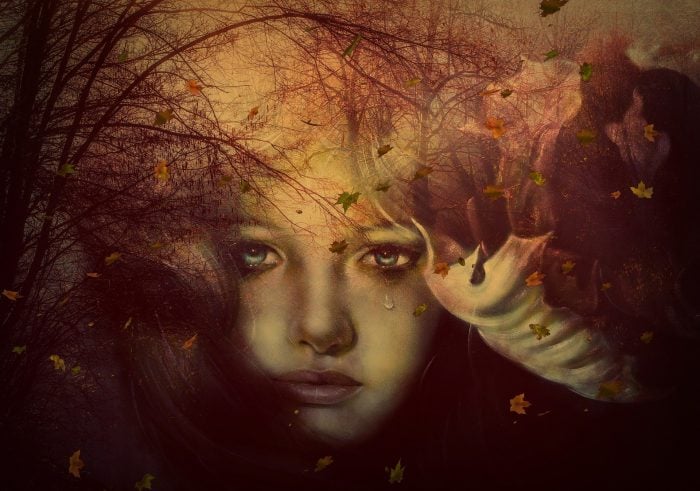When we develop in an environment where we do not feel accepted, respected, wanted, or loved, we learn attachment and love as an absence.
We become dissociated from our needs, from our true self via the soul loss of the truly human need to belong through acceptance and care of the soul self.
This sets up the deep internal dynamic of shame, along with domination, oppression, fear, and control as being associated with love in ways that feed the codependent dynamics we’ve come to believe are so normal. So normal, in fact, that even our spirituality and personal development work is infiltrated with an unconscious paradigm that if we aren’t loved or getting what we want, there’s something wrong with us and we need to do the “work” to fix it.
Shame is the invisible current beneath any codependency.
We learn to be attracted to people who don’t care about us because it awakens the unconscious connection between disconnection and love. We are drawn to it, either trying to “get” the love, or feeding off of the affection of others that makes us feel better—even if we don’t feel that way in return.
Perhaps we could frame this as an addiction, an unconscious search for loving connection. This dynamic is enmeshed in our culture—so much so that it is emotionally traumatic, as we no longer live in an emotionally sober world that respects the humanity of others.
This sets us up for consumption that is normalized through every possible source of conditioning imaginable.
Buy more.
Do more.
Drink more.
Smoke more.
Work harder.
Meditate longer.
Deprogram yourself.
Fix your thinking.
Ascend from your pain.
Change your appearance.
Uplevel your branding.
Align with what you want on the outside.
More is not enough.
More.
And.
More.
The underlying core message is that you are not okay as you are. If you are not okay as you are, you aren’t worthy of love or flourishing—and if you aren’t loved or flourishing, there is something wrong with you.
It’s quite noxious.
I got so trapped in this that it took a serious relapse back into a relationship with alcohol and a subsequent spiritual awakening, triggered by my recovery from addiction, to see that I was addicted to trying to fix myself, to “get” things I wanted, and to make my way in a world that didn’t have any space at all for me—for my true gifts and who I really am.
It made me want to drown my true self because I didn’t know what to do with her.
This is what I learned from my family, from school and society; this is exactly how I treated myself. I was drawn to people who didn’t like me, and if alone, I didn’t like me and I treated myself badly.
We designed computers to be like us, and now we have somehow come to think of ourselves as computers that need to be debugged. To work in the matrix, to get the right program running.
We are human.
Not computers.
There’s a developmental healing continuum that needs to happen from associating “not love” and attachment to that energetic to being attracted to people who truly care and are capable of loving, without finding fault in them because our shame has us thinking something is wrong with someone who wants us.
This is our cultural attachment disorder.
This is relational trauma that gets mirrored in our inner world.
We reject a part of ourself, the one who was never loved, and our shame—the grief of never having been loved and the fear of not being loved—runs the show and selection process with hyper vigilance for anyone available, and we lose discernment for anyone who awakens our unconscious association to love as lack.
The truest scarcity in our hearts has been the lack of real love.
In healing our wounds from a lack of love, we heal our relationship with love, with a loving source of life, and, hence, reconnect with the loving aspect of ourselves that has us, ultimately, get into alignment with our truest selves—which will then be more available to the flow of true love in our lives.
It’s simple. More simple than all the mind games we play with ourselves.
But, that doesn’t mean it’s easy.
It’s the love warrior’s journey to approach that which was not love, to witness the wounds of not being loved, and to grieve the loss of not being loved. To mourn for oneself, for the system, and all that was lost and never will be because it wasn’t available.
This starts to heal this generational traumatic transmission of a lack of love.
We start to mourn our relationship to the lack of love, to pour golden salve over the parts of us that awaken when “not love” is on the table. We acknowledge our relationship to this dynamic and how it lives inside of ourselves.
For, we are quick to point out the narcissism (a profound demonstration of deep, debilitating shame we all carry) in others, but not in ourselves.
We must mourn the parts of ourselves that formed in the consciousness of a scarcity of love. For this is not who we are, or how we are, nor who, I believe, we truly desire to be on this planet at this time.
In this grief, we allow love to open our hearts and resurrect a channel of love that helps us reorient ourselves to love, to life in a more benevolent and loving way that, ultimately, has us reclaim parts of our soul and power, so we live life more whole, embracing of love, unafraid of shadows, and safer in our own skin—which makes us safer for others, and ready to discern when safe love is present.
To safe, true, divine love and our alignment with our deepest, truest, and most loving selves.
More love.
Not less.
~








Read 35 comments and reply